Government minister Robert Jenrick chucked another culture war hand grenade this week, making it clear to local councils that they should routinely fly the Union Flag from their buildings. The reaction in some quarters was much as you might expect, with a good deal of leaden attempted humour at the expense of the poor benighted fools who’ve been tricked by the dastardly Tories into liking the symbols of the free, peaceful and prosperous country in which they live.
Somewhat neglected amid the kerfuffle was the second part of Jenrick’s announcement, namely that the Tories intend to “cut red tape” to allow councils to fly the flags of the historic English counties. It’s not entirely clear what regulations currently prevent local governments from getting someone to run a flag up a pole, but I’m quite ready to believe that they exist.
Speaking for myself, I’d be delighted to see more county flags flying from town halls. Here in Kent we have the white horse rampant on a red background, whose provenance is sometimes traced back as far as the legendary brothers Hengest and Horsa. They are traditionally considered the founders of the Kingdom of Kent, which enjoyed a short spell of importance in early Anglo-Saxon England, before its eclipse by first Mercia and later Wessex, and is notable as the first of the kingdoms of the Heptarchy to adopt Christianity.
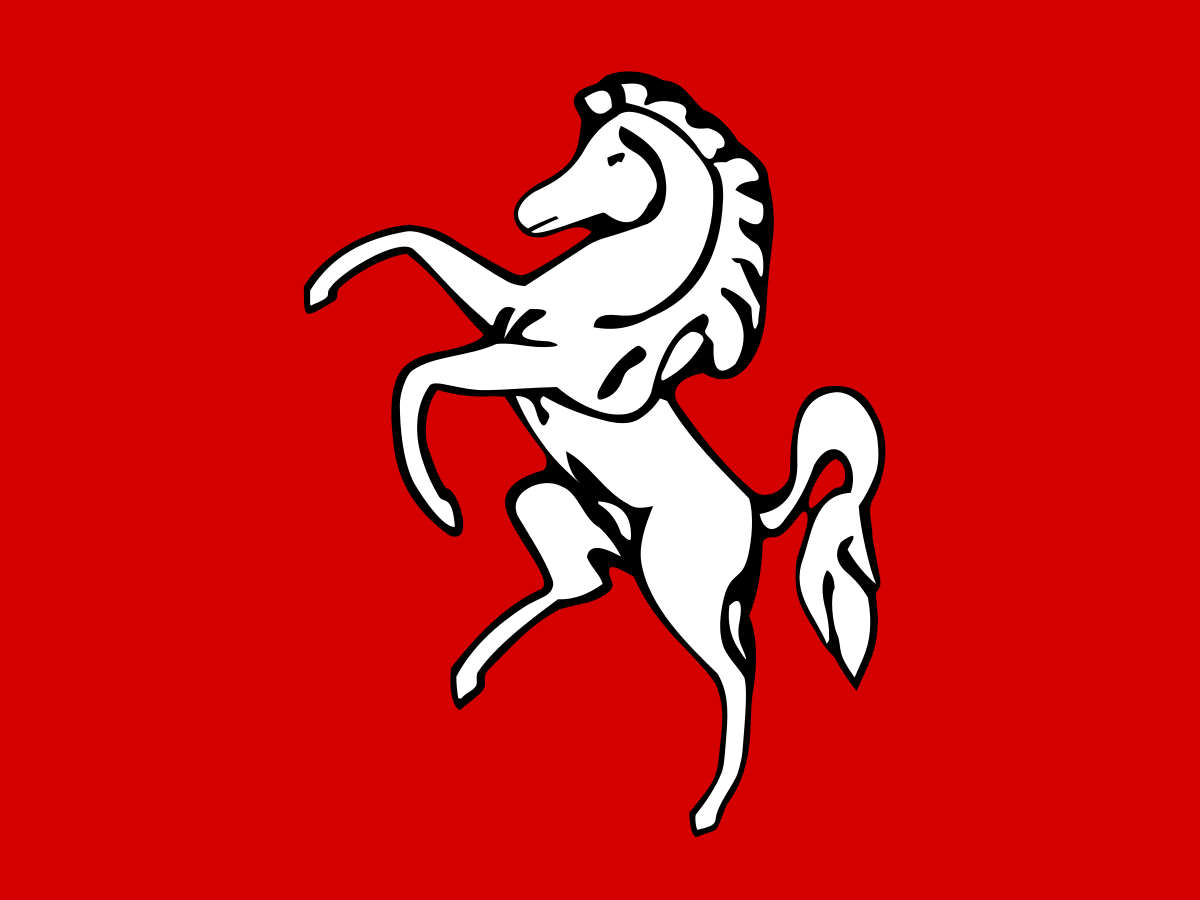
The emblem of our neighbours Essex similarly harks back to early English history, with its three fearsome Saxon swords.
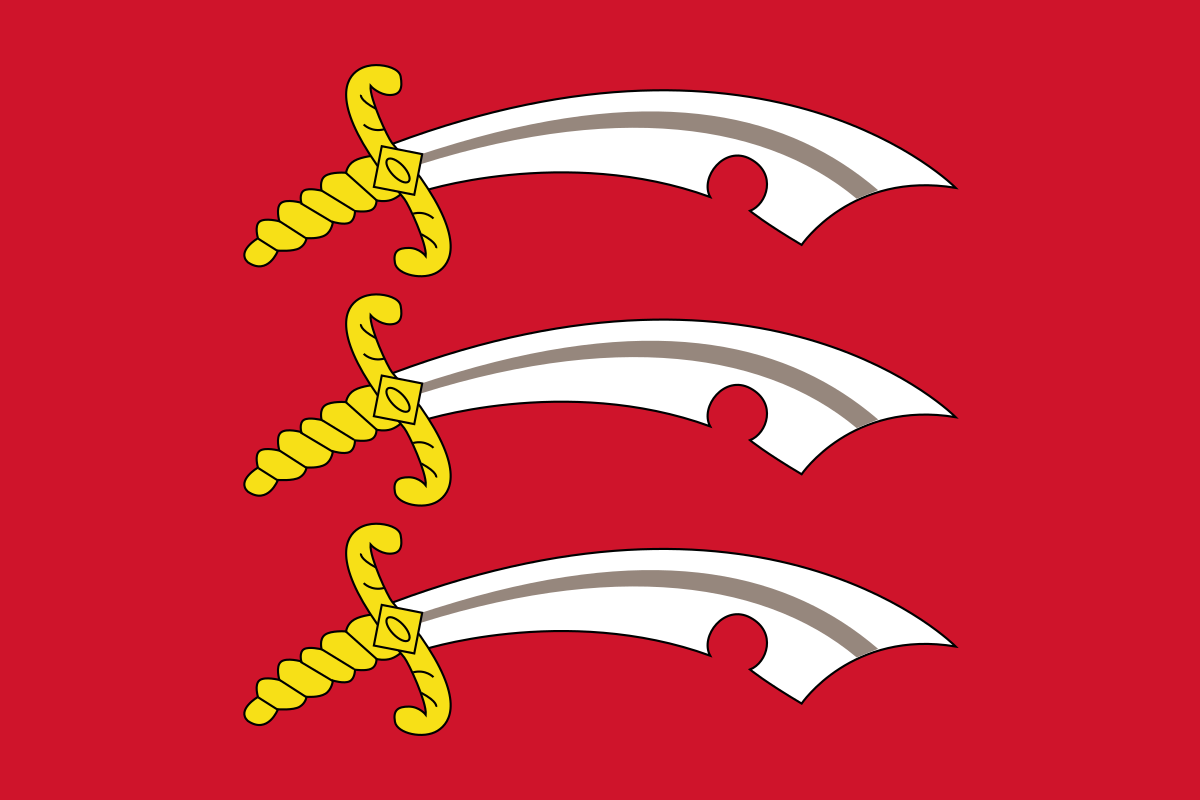
Almost identical weapons appear on the flag of Middlesex, now sadly almost entirely consumed by Greater London, which had close connections to Essex.
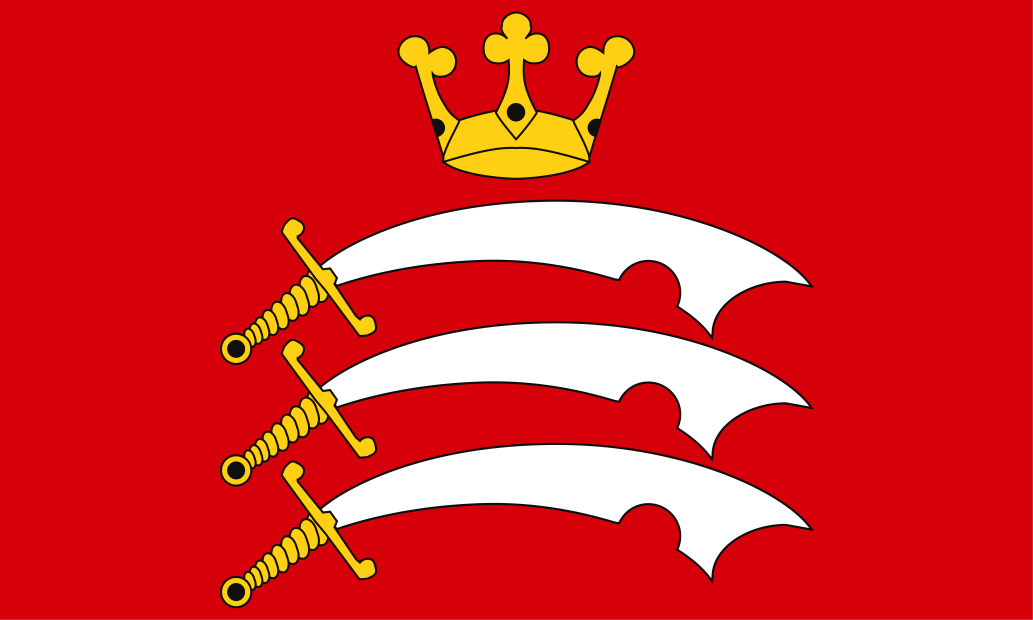
East Anglia as a whole has a coat of arms with three gold crowns which is thought to date back to the seventh century. It seems to have inspired the MR James ghost story A Warning To The Curious, in which an amateur archaeologist courts disaster by digging up an Anglian crown.

Other county flags’ origins may lie even further back than the Anglo-Saxons. The Cornish cross, white on black, is usually associated with St Piran, a near-contemporary of St Patrick. Piran was a real person, a hermit and later an abbot, but real information about his life and work is scarce, clouded by folk tales and medieval hagiography.
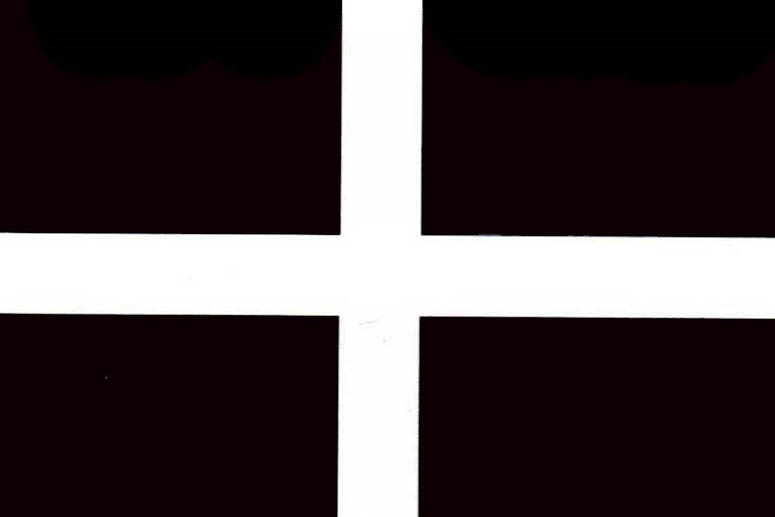
Not all county flags have such long lineages. The one used by Cornwall’s old rival Devon was only conceived and adopted in the early years of this century, although it is dedicated to an aristocratic sixth-century British saint, St Petroc, and uses colours that have a long association with the county.
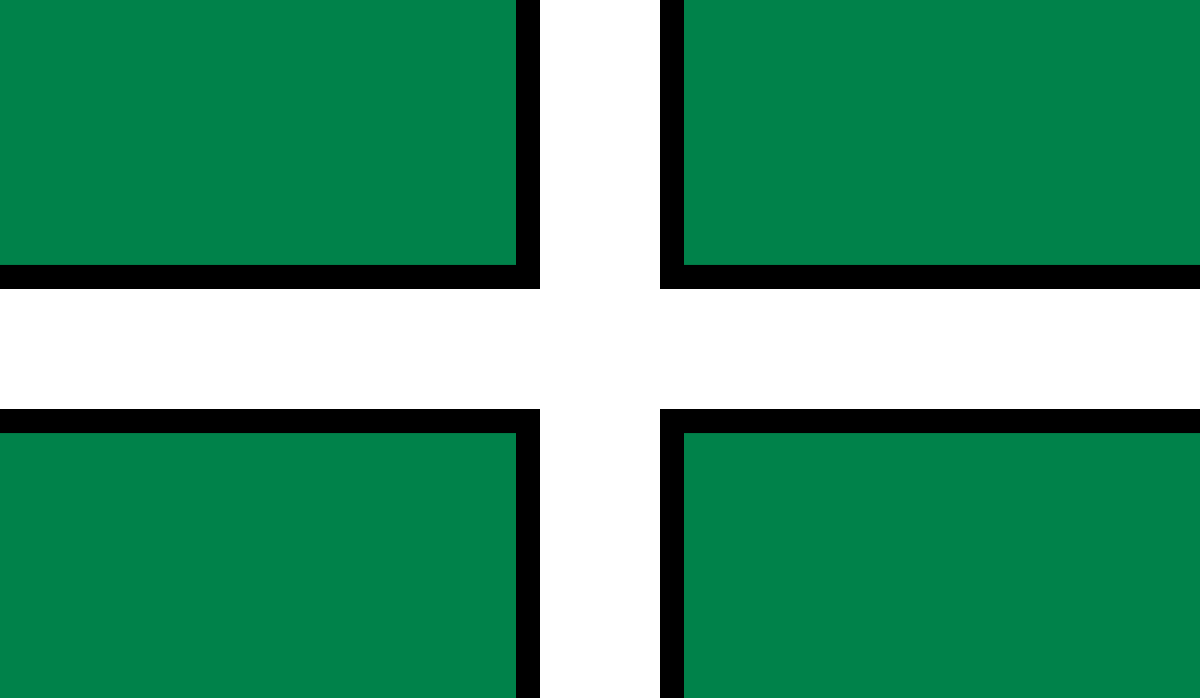
Durham also uses a new design, incorporating the cross of St Cuthbert, that was finalised less than a decade ago. For a long time the coat of arms of the Bishop of Durham had been used for official purposes. This was an indication of the long period during which the holder of that office enjoyed considerable secular power in northern England, in his capacity as the Prince-bishops of the County Palatine of Durham. Many of the county palatinate’s distinctive legal arrangements survived into the nineteenth and twentieth centuries.
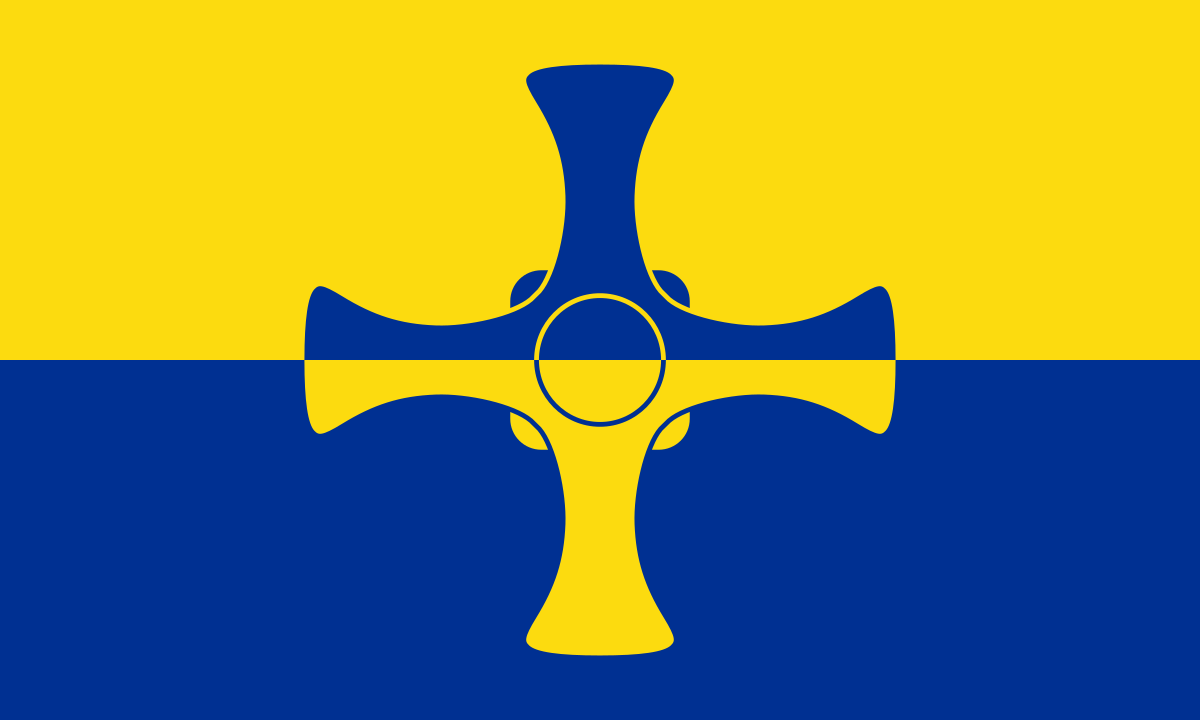
In recent years, many of the historic counties of England have declined in administrative importance, or been abolished altogether. But the adoptions of new flags, rooted in the history of particular places, suggest that people’s attachment to those places might be more persistent than we thought.








Join the discussion
Join like minded readers that support our journalism by becoming a paid subscriber
To join the discussion in the comments, become a paid subscriber.
Join like minded readers that support our journalism, read unlimited articles and enjoy other subscriber-only benefits.
SubscribeI am not particularly nationalistic and usually, for instance, want the England football team to lose. However, with the mass immigration of all manner of different cultures comes the need to unite them around something. And that something should probably be the country in which they live, otherwise you will have Balkanisation and societal collapse etc.
County flags seem to be a delightful and historic thing.
I always want England football teams to lose because pundits and newspapers talk them up so much. If it wasn’t for the stupid pundits I would want them to win.
Yes, I will their failure for more or less the same reasons. And because the FA are bunch of grasping so-and-sos.
Do they Kneel? I do not watch any professional sports where any team kneels.
And because the footballers themselves are overpaid prima donnas?
I see you adopt the Scottish system – first support Scotland then any team as long as it isn’t England. Strange.
Not really – I go with the ChrisWs comments – the pundits are deeply irritating.
However, we generally ‘return home” when there is a proper knockout match against a prominent EU side.
I have always admired the way continental countries do this – as it suggests they have more pride in their communities than British folk.
On the downside, we must expect that moronic ”flag cancellers” will now start appearing out of the woodwork.
Boris should start the ball rolling and copy Trump, wearing a baseball cap with a UK flag for every press conference.
Boris was MP for Uxbridge, he could wear the three swords of Middlesex. It is a red background too. MMGA (make Middlesex Great Again) so a Red baseball cap with MMGA and the three swords on the Front. For the Union Jack I want him to wear a sleeveless T-shirt made from one.
That would be the only possible thing he could do to get me to want to vote for him.
In particular, I love Siena where – as one wonders around that beautiful city – one can see which contrada one is in by the flags flying from – pretty much – every house/building.
I think the idea of county flags is brilliant. The Union Jack and the flag of England have all sorts of political issues building around them, hidden meanings if you like. Flags would brighten everything up in the gloom of winter.
Also, wherever I go I have to look at the Welsh flag in the gardens of houses, especially now we have a pending election. Why can’t we all have flags?
I fly the flag of my mother’s islands (Kiribati) whenever I can (it’s a beautiful, colourful flag).
On the same topic I would like a return to the three lions/leopards rampant as the flag of England.
Little to no association with BNP, football hooliganism and other more negative associations, and a deliberate reminder to the fact that England is one of the oldest countries in the world.
Along with the county flags I think this could form part of a more sober, respectful, reinvigoration of the history of England.
Wasn’t that the personal standard of the monarch not the country’s flag. Bit like the boar was the standard for Scottish kings for a long time.
Indeed – it predates our more modern concept of nation really.
Also the irony is lovely that the three lions arguably represent French domination of the English; the first two coming over with the Normans and the third being added by our first Angevin king.
So to you anyone using the National Flag for patriotic reasons is Nazism? No wonder UK is circling the plug hole as you despise your nation, the Greatest Nation Which Ever Existed, the one which brought more freedom, prosperity, intellectualism, education, industry, science, rule of law, suffrage, trade, good Governance, than any in History, and you think its Flag is Fascist?
The self loathing pathology has spread through the communist liberal teaching and MSM industry till UK is doomed.
You British have drunk the hateful Kool-Aid and is why I am so glad I left for a land where they fly their flag with Pride.
So to you anyone using the National Flag for patriotic reasons is n& z**m? No wonder UK is circling the plug hole as you despise your nation, the Greatest Nation Which Ever Existed, the one which brought more freedom, prosperity, intellectualism, education, industry, science, rule of law, suffrage, trade, good Governance, than any in History, and you think its Flag is Fa *& is t?
The self loathing pathology has spread through the communist liberal teaching and MSM industry till UK is doomed.
You British have drunk the hateful Kool-Aid and is why I am so glad I left for a land where they fly their flag with Pride.
(edited to remove the word to try to get it through moderation, as it is being stopped, for I assume that, or canceled, as it were.)
Relax old bean. Quite how you got any of that from what I wrote says more about yourself than anything.
No I just prefer the older traditional flag. Like it or not, agree with it or not, the St George’s cross has picked up a few negative associations on the way. This is what I refer to by “sober and respectful” (hardly “n& z*” and “Fa *& is t” is that now?) in adopting the older flag.
My main reason for preferring the old flag is that it is tied closer to the origins of modern England – an era of Magna Carta, the gradual replacement of English over French in the Royal court, Order of the Garter etc.
All fairly silly and nostalgic and no communist or liberal in sight. Fret not.
Yes let’s restore county flags, and let’s also restore the functions and powers of county councils. That’s genuine devolution/subsidiarity, unlike the fake regions foisted upon us by Blair and the EU
Yeah. I’d like to do away with the regional governments and go direct to regions. Bring back Yorkshire!
What a wonderful development! And another two fingers to the pernicious torrent of wokeism. The more people there are, the more we need binding symbols of local togetherness – whatever the race, gender, etc. – exactly what the woke want but misrepresent in their usually own belligerent, contradictory way.
Reading this article gave me cause to find out what the county flag of Cheshire is. I learnt that it’s a blue flag with three golden wheatsheaves and a golden sword. Further reading on the Flag Institute website, ( God bless geeky sites like these ) states that it refers back to Cheshire being a county palentine.
Well now I’m angry and upset. Fancy celebrating the imposition of Norman colonial supremacy over my Anglo Saxon and Briton forebears! Decolonise the county flag structure now!!!
It may be time to start defacing any such flags that I see, in a symbolic gesture protesting against the enslavement of my ancestors, and the Normanwashing of their culture by a callous invasion force.
Bloody Normans, coming over here and …..
The people of Northumberland seem very keen on flying their flag already: it’s quite noticeable to a visitor, and it increases the sense of having arrived somewhere distinctive.
Caithness where I now live (born in Yorkshire) has a new flag designed a few years ago (2016) in a competition.
Whilst I know its only symbolic there’s no way I’d want to sail in a ship built to the design on the flag <G>
Ideally we will see some of these historic counties being returned as well as their flags. Bring back the counties of Huntingdonshire, Banffshire and Middlesex I say
Flying of flags is controlled by the Town and Country Planning (Control of Advertisements) (England) (Amendment) Regulations 2012. These allow anyone and any organisation to fly, without planning permission, any of the following:
(a) Any country’s national flag, civil ensign or civil air ensign;
(b) The flag of the Commonwealth, the European Union, the United Nations or any other international organisation of which the United Kingdom is a member;
(c) A flag of any island, county, district, borough, burgh, parish, city, town or village within the United Kingdom;
(d) The flag of the Black Country, East Anglia, Wessex, any Part of Lincolnshire, any Riding of Yorkshire or any historic county within the United Kingdom;
(e) The flag of Saint David;
(f) The flag of Saint Patrick;
(g) The flag of any administrative area within any country outside the United Kingdom;
(h) Any flag of Her Majesty’s forces;
(i) The Armed Forces Day flag.
Presumably, it’s (b) that requires amendment to remove mention of the EU. Otherwise, most anything goes.
The flag of the Black Country.
watch how those who persistently seek offence manage to find it in the Black Country flag.
first, there is the actual name – “Black Country” – ooooh, waycist
second, the flag itself- ooooh, waycist
despite the fact neither are
Let’s hope all these flags get made in the UK!
“It’s not entirely clear what regulations currently prevent local governments from getting someone to run a flag up a pole, but I’m quite ready to believe that they exist.”
There aren’t any. So many (most) LAs already fly the flag.
Even in my irredeemably leftie borough of Islington (where we have no county flag anymore) the Town Hall proudly flies the Union Flag alongside Islington’s historic flag celebrating its medieval and Tudor history.
This article (and the govt statement) is all whistles and dogs. Now that would make a good flag.
“It’s not entirely clear what regulations currently prevent local governments from getting someone to run a flag up a pole, but I’m quite ready to believe that they exist.”
There aren’t any. So many (most) LAs already fly the flag.
Even in my irredeemably leftie borough of Islington (where we have no county flag anymore) the Town Hall proudly flies the Union Flag alongside Islington’s historic flag celebrating its medieval and Tudor history.
This article (and the govt statement) is all whistles and dogs. Now that would make a good flag.